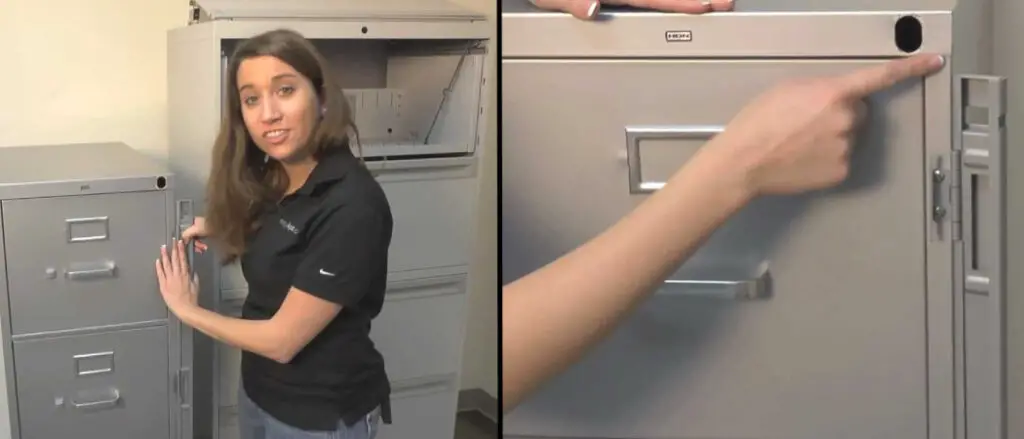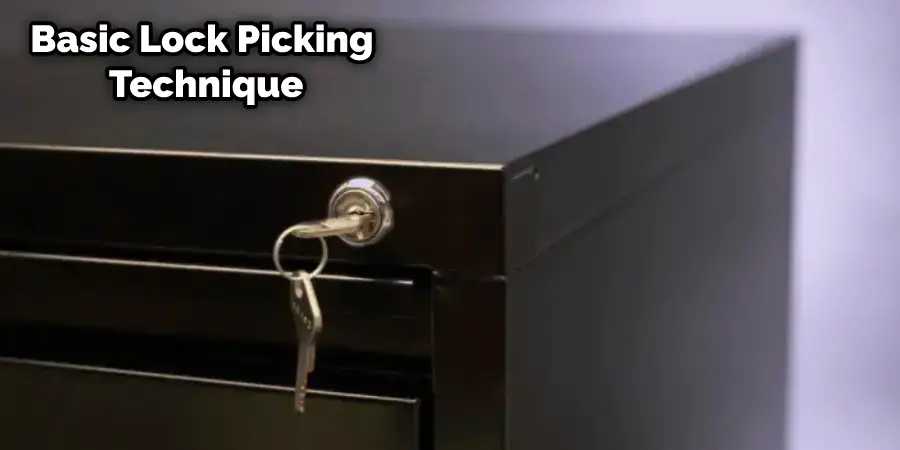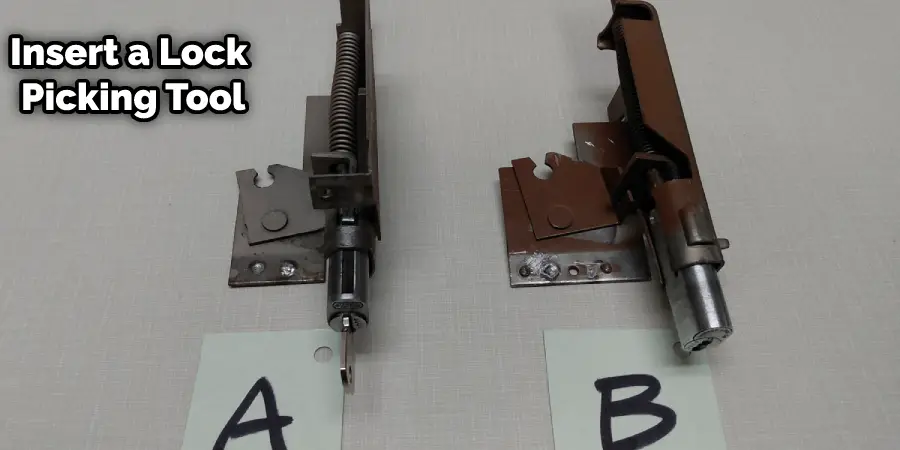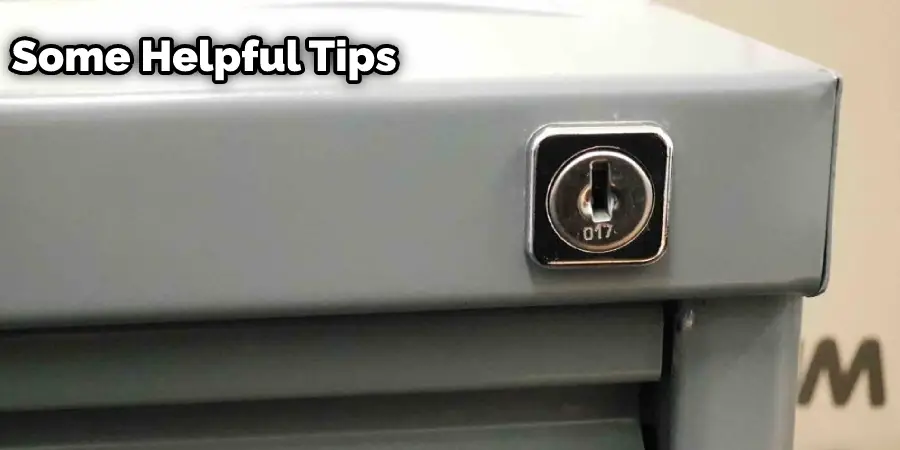Have you ever locked yourself out of your file cabinet by accident? If so, you know that the frustration and stress involved can be immense. Fortunately, it’s possible to quickly and safely pick a desk lock without any professional assistance or expensive tools — all it takes is some basic knowledge and a steady hand.

In this guide, we’ll provide an in-depth look at how to pick a filing cabinet lock using simple household items like paper clips and tweezers. We’ll also go into detail on when picking is the right approach, what precautions should be taken during the process, and helpful tips for success.
Whether you’re simply interested in becoming more literate with locks or are faced with an emergency lockout situation, this post will provide step-by-step guidance through every stage of lockpicking. So keep on reading to learn more about how to pick a file cabinet lock.
Basic Lock-Picking Techniques
At the most basic level, lock-picking is simply a matter of manipulating pins inside the keyhole to align with the shear line. This means that lock-picking relies on an understanding of how locks work and how to apply pressure correctly. There are various techniques for picking file cabinet locks, but we’ll focus on two of the most effective.
The first technique works best on wafer-style locks, which are the most common type of file cabinet locks. This process involves using a paperclip to insert into each pin chamber and push the pins up until they align with the shear line. It’s important to be gentle, as too much pressure can cause damage to the lock.

The second technique is ideal for pin-and-tumbler locks, which are slightly more sophisticated and require a bit more finesse. This process involves using tweezers to pick each individual pin up until it reaches the shear line. Again, it’s important to be gentle while picking this type of lock to avoid damaging it.
10 Step-By-Step Guides on How to Pick a File Cabinet Lock
Step 1: Gather the Necessary Tools:
You will need a paperclip or tweezers, depending on the type of lock you’re picking.
Step 2: Insert Lock Picking Tool:
For wafer-style locks, insert the paperclip into the keyhole and press it against each pin chamber. If you are picking a pin-and-tumbler lock, use tweezers to place pressure on each pin.

Step 3: Apply Pressure:
Gently apply pressure to each pin until it aligns with the shear line. You may need to adjust the pressure slightly for some locks, but it should be minimal.
Step 4: Test the Lock:
Once you have aligned all of the pins, test the lock by turning the key or inserting a paperclip into the keyhole. If it successfully unlocks, you have successfully picked the lock!
Step 5: Repeat if Necessary:
If the lock does not unlock after your first attempt, start again from step one and make sure to apply even pressure.
Step 6: Check for Damage:
Before unlocking the file cabinet, check for any damage to the lock caused during the process. If you find any, call a locksmith or replace the lock entirely.
Step 7: Lubricate Lock:
If there is no visible damage, lubricate the lock with graphite powder to ensure it functions properly in the future.
Step 8: Store Lock Picks Safely:
Keep your lock picks in a safe location to prevent them from being used for nefarious purposes. It’s also important to make sure that children and pets can not access them.
Step 9: Close Cabinet:
Once you have successfully picked the file cabinet lock, close the cabinet and make sure it is secure.
Step 10: Remove Lock Picks:
Once the file cabinet is locked, remove your lock picks from the keyhole and store them in a safe place.
Safety Precautions and Helpful Tips
Since lock-picking is a delicate process, it’s important to take certain precautions in order to prevent any damage or injury. Here are a few safety tips to keep in mind when attempting to open your file cabinet with this method:
• Always wear eye protection when picking locks.
• Avoid applying too much pressure to the pin chambers, as this can damage the lock.
• Be prepared for unexpected results; locks may not open after your first attempt.
• If you find any visible damage to the lock, do not attempt to pick it up and call a professional instead.
• Make sure that lock-picking tools are stored securely and away from children and pets.
• Always lubricate the lock after picking it to ensure that it functions properly.
• Make sure to close and lock the cabinet once you have finished unlocking it.
• Know when to call a professional; if you find yourself having difficulty with the lock, it is best to call a locksmith.
• Do not attempt to pick any lock that you do not own or have permission to open.

By following these safety tips and guidelines, you can ensure that your filing cabinet stays secure while minimizing the risk of injury or damage to the lock. Lock-picking may seem intimidating, but with some patience and practice, it can be a useful skill to have in your toolbox.
Troubleshooting Tips on How to Pick a File Cabinet Lock
1. Apply Minimal Pressure:
Too much pressure can cause damage to the lock and pins, so be sure to apply only light pressure when picking a file cabinet lock.
2. Make Sure Pins are Aligned:
If the pins are not aligned correctly, the lock will not open. Check each pin chamber for alignment before attempting to unlock it.
3. Don’t Force:
If the lock does not open after multiple attempts, stop and call a locksmith. Applying too much force can break the pins or cause irreparable damage.
4. Lubricate After Unlocking:
After unlocking the file cabinet, be sure to lubricate it with graphite powder to prevent it from seizing up in the future.
5. Store Lock Picks Safely:
Once you are done with your lock-picking tools, store them in a secure place where children and pets cannot access them.
6. Ensure the Cabinet is Securely Locked:
Before leaving the file cabinet, make sure it is securely locked and cannot be opened without a key or lock-picking tools.
By following these tips and using some patience, you will have no trouble successfully unlocking your file cabinet with a lockpick. Just remember: safety first!
Different Types of Locks Commonly Used on File Cabinets
1. Combination Locks:
Combination locks are popular for file cabinets because they don’t require a key, which can be lost or stolen. Instead, they use a series of numbers or symbols to unlock the lock. Combination locks can be either manual or electronic, with electronic locks allowing for more complex combinations and easier resetting of the combination.
Combination locks provide high security since they require knowledge of the correct combination to open. They’re also convenient since they don’t require a key, making them a good choice for shared cabinets where multiple people need access.
Combination locks can be time-consuming to unlock since the user must enter the correct combination each time. Additionally, combination locks can be vulnerable to being guessed or cracked if the combination is not changed regularly or if the lock is of poor quality.
2. Keyed Locks:
Keyed locks are the most traditional type of lock and use a key to open the lock. They come in various types of keyways, such as pin tumblers, wafer tumblers, and disk detainers.
Keyed locks are easy to use and are typically reliable, providing good security against unauthorized access. They’re also a good choice for those who prefer physical keys over digital codes.
Keyed locks can be vulnerable to lock picking and key duplication, making them less secure than combination or electronic locks. They can also be more difficult to open if the key is lost or stolen.
3. Electronic Locks:
Electronic locks use a digital code to unlock the lock and are becoming increasingly popular for file cabinets. They may use a keypad, fingerprint scanner, or proximity sensor to unlock the lock.
Electronic locks are highly secure, providing good protection against unauthorized access. They’re also easy to use and can be programmed to allow multiple users with different codes, making them a good choice for shared cabinets.
Electronic locks can be more expensive than other types of locks, and they may require batteries or electricity to operate. They may also be vulnerable to hacking or other forms of digital attack.
Overall, the best type of lock for a file cabinet depends on the level of security needed, the number of people who need access, and the budget available.
Combination locks and electronic locks are generally more secure than keyed locks, but they may be more expensive and require more maintenance. In any case, it’s important to choose a high-quality lock from a reputable manufacturer to ensure the best possible security for your file cabinet.
Alternative Methods to Open a File Cabinet
While lock picking is the preferred method for opening a file cabinet, alternative methods can also be used. However, these methods are generally less reliable and may cause damage to the cabinet, so they should only be used as a last resort. Here are two common alternative methods:
- Using a drill:
Using a drill involves drilling a hole in the cabinet near the lock and manipulating the lock from the inside using a small tool, such as a screwdriver. This method can be effective, but it can also cause damage to the cabinet and the lock.
Risks: Drilling a hole in the cabinet can damage the lock and the surrounding area, making the cabinet unusable. Additionally, this method may not work on all types of locks, and it may not be a viable option for those who want to maintain the appearance of the cabinet.
- Using a pry bar:
Using a pry bar involves using a lever to force the cabinet open. This method can be effective, but it can also cause significant damage to the cabinet.
Risks: Using a pry bar can cause damage to the cabinet and the lock, making it difficult to use the cabinet in the future. Additionally, this method is generally not recommended for those who want to maintain the appearance of the cabinet.
Overall, lock picking is the preferred method for opening a file cabinet since it’s the most reliable and least damaging method. It allows the lock to be opened without causing any damage, which is important for those who want to continue using the cabinet. Additionally, lock picking is a skill that can be learned and mastered with practice, which makes it a more accessible option for those who want to open their cabinet without causing any damage.
Frequently Asked Questions
Q: What Is the Best Type of Lock for A File Cabinet?
A: The best type of lock for a file cabinet depends on your security needs and budget. Combination locks and electronic locks are generally more secure than keyed locks, but they may be more expensive and require more maintenance.
Q: How Long Does It Take to Pick a Lock?
A: The time it takes to pick a lock can vary depending on the complexity of the lock, the skill level of the person picking it, and the tools being used. Some locks can be picked in just a few seconds, while others may take several minutes or longer.
Q: Can You Damage a Lock by Picking It?
A: If done correctly, lock picking should not damage the lock. However, using excessive force or the wrong tools can cause damage to the lock and the surrounding area.
Q: Can Lock Picking Cause Any Legal Issues?
A: While owning lock-picking tools is legal in many places, using them to gain unauthorized access to a property or object is illegal and can result in legal consequences.
Conclusion
Picking a file cabinet lock can be tricky and intimidating, but with the right tools and knowledge, it is possible. With this guide, you will have a better understanding of how to pick a file cabinet lock in order to access your important documents quickly.
Even if it takes some practice before you master the technique, having these tips on hand will help make sure that when the time comes for you to open up those locked cabinets, all you need are two paper clips!
Remember that while filing cabinets may provide extra security against theft or unauthorized access, they don’t always guarantee absolute safety – so use caution whenever trying out any new techniques, such as picking locks. Thanks for reading this article about how to pick a file cabinet lock.
